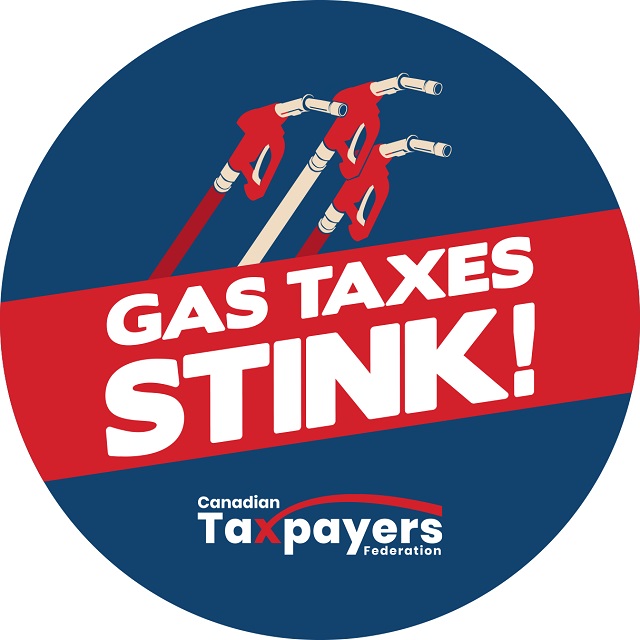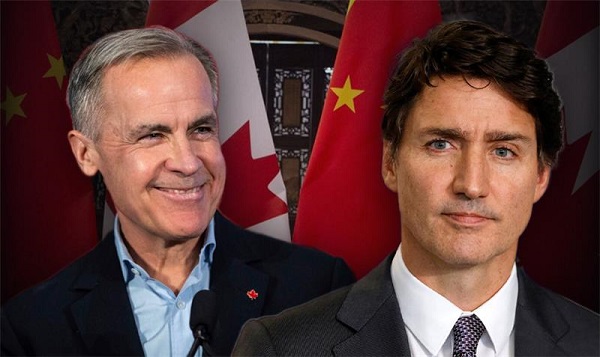National
Canadians pay dearly in gas taxes – it’s only going to get worse

From the Canadian Taxpayers Federation
Author: Jay Goldberg
Two thousand dollars. That’s how much the typical two-car family spends on gas taxes every year.
Big numbers can sometimes be hard to process. But the feeling of dread Canadians get as the gas metre ticks up sure isn’t.
Go to the gas station and you’ll see moms filling up the minivan before soccer practice, praying the metre doesn’t tick past $100 so she can afford to take the kids to McDonald’s after an hour of drills.
Or dads fueling up after a week of long commutes to the office, who might choose to only fill the tank halfway in order to have enough money left over to pick up groceries on the way home for Friday night dinner.
All too often, folks will throw up their hands when they see the gas bill, not knowing who to blame. But the truth is a lot of the fault for high gas prices lies at the feet of our politicians.
The average price of gas in Ontario late last month was $1.66 per litre. Out of that total per litre cost, a whopping 56 cents was taxes.
That means that more than a third of the price of gas is taxes, money going out of the pockets of hardworking families and into the coffers of big government.
A family filling up a Dodge Caravan and Honda Accord once every two weeks ends up paying just shy of two grand in gas taxes over the course of a year.
That’s the equivalent of two months’ worth of groceries for a family of four.
Yes, gas taxes have been around for decades. But politicians today, particularly those in Ottawa, keep driving the tax burden higher and higher.
The Trudeau government’s carbon tax now costs 17.6 cents per litre. For that family filling up the Caravan and Accord once every two weeks, over the course of a year, the carbon tax bill alone will reach $604.
And it’s a cost that wasn’t charged at the pump just six short years ago.
If a 56 cent per litre tax bill sounds bad to you now, just wait until you see what Prime Minister Justin Trudeau has in store for Canadians.
Trudeau plans to keep raising his carbon tax each and every year until 2030.
Today, the carbon tax costs 17.6 cents per litre of gas at the pumps. In six years, with Trudeau’s two carbon taxes fully implemented (the second one coming through fuel regulations), that number will be 54.4 cents per litre.
And that will bring the total per litre tax bill to $1.04.
By 2030, that same family filling up the Caravan and Accord every other week will be paying over $1,800 in carbon taxes. And the cost of overall gas taxes per year will hit $3,570.
This is a future Canadians can’t afford. And the federal carbon tax is making that future unaffordable.
The Trudeau government has tried to argue that somehow, by charging a carbon tax, paying bureaucrats to collect the carbon tax, charging sales tax on top of that carbon tax, and then using a magic formula to send some of that money back to taxpayers, Canadians will be better off.
Anyone who buys that should be looking for a beachfront property in Saskatoon.
And there are no refunds for Trudeau’s second carbon tax.
For those wondering, there are politicians out there willing to cut fuel taxes to make life more affordable at the pumps.
Provincial governments of all stripes, from the Liberals in Newfoundland and Labrador to the Progressive Conservatives here in Ontario to the NDP in Manitoba, have cut fuel taxes, saving families hundreds of dollars.
Trudeau’s scheduled carbon tax hikes over the next six years will crush family budgets like an asteroid wiping out the dinosaurs. It’s time for the feds to learn from the provinces and lower costs at the pumps.
That means putting scrapping the carbon tax at the top of the agenda.
International
Beijing’s blueprint for breaking Canada-U.S. unity

By Stephen Nagy for Inside Policy
For several decades, China has pursued a sophisticated campaign to fracture the world’s most integrated defense partnership—that between Canada and the United States.
Beijing’s strategy goes beyond typical diplomatic pressure: it systematically exploits every Canada-US disagreement, transforming routine alliance friction into seemingly irreconcilable divisions. This has become a degree of magnitude easier under US President Donald Trump, with his mercurial policy shifts towards Ottawa. The revelations about Chinese interference in Canadian elections from the Security and Intelligence Threats to Elections (SITE) Task Force – a body comprised of Canadian government and security officials which monitors elections threats – illuminate only one dimension of this comprehensive assault on North American solidarity.
Beijing’s strategic logic is to divide and conquer. By portraying Canada as sacrificing sovereignty for American interests while simultaneously painting legitimate Canadian security concerns as US-driven paranoia, Beijing paralyzes Ottawa’s decision-making and undermines continental defense cooperation.
The 2018 arrest of Huawei CFO Meng Wanzhou crystallized China’s approach. When Canada honored its extradition treaty with the US by detaining Meng at the Vancouver airport, Beijing immediately framed this routine legal cooperation as evidence of Canadian subservience. Chinese state media didn’t simply criticize the arrest, they specifically portrayed Canada as “a pathetic clown” and “running dog of the US.”
Within nine days, China retaliated by detaining Michael Kovrig and Michael Spavor, holding them for 1,019 days. But Beijing’s messaging revealed its true objective. Chinese diplomats repeatedly demanded Canada “correct its mistake” by defying the U.S. extradition request. Ambassador Lu Shaye explicitly stated Canada could resolve the crisis by demonstrating “independence” from Washington.
The economic pressure followed the same pattern. China banned canola imports from two major Canadian companies in March 2019, citing “pests” but Chinese officials privately linked the ban to the Meng case. When targeting Canadian meat exports, Beijing’s timing again coincided with moments of US-Canada cooperation on Huawei restrictions.
China’s wedge strategy extends beyond retaliation to proactive exploitation of bilateral tensions. During the Keystone XL pipeline disputes, Chinese state media amplified Canadian grievances while offering Beijing as an “alternative partner” for energy exports. When the Biden administration cancelled the pipeline in 2021, Chinese diplomats and media immediately highlighted American “betrayal” of Canadian interests.
Similarly, during US-Canada disputes over softwood lumber tariffs and Buy American provisions, Chinese officials consistently present themselves as more reliable economic partners. The message is always the same: American protectionism harms Canadian workers, while China offers stable market access conveniently omitting Beijing’s own coercive trade practices.
On defense, China exploits Canadian concerns about Arctic sovereignty vis-à-vis the United States. When Washington challenges Canada’s claims over the Northwest Passage, Chinese media amplify these disagreements while positioning Beijing as respecting Canadian Arctic sovereignty – even as China declares itself a “near-Arctic state” and seeks military access to the region.
Recent intelligence revelations confirm China’s systematic attempts to influence Canadian politics specifically to create US-Canada friction. According to CSIS documents, Chinese intelligence assessed that a Liberal minority government would be less likely to follow Washington’s harder line on China. Beijing’s interference operations during the 2019 and 2021 elections specifically targeted Conservative candidates perceived as pro-American on China policy.
The Chinese United Front Work Department cultivates Canadian political and business figures through seemingly innocent organizations. A 2020 National Security and Intelligence Committee report found these groups specifically encouraged narratives about American “bullying” of Canada and promoted “made-in-Canada” foreign policies that coincidentally aligned with Chinese interests.
Chinese diplomats regularly exploit Canadian media to amplify anti-American sentiments. During USMCA negotiations, Chinese officials gave exclusive interviews to Canadian outlets sympathizing with “American strong-arm tactics.” When Canada considered banning Huawei from 5G networks, Chinese embassy officials published op-eds in Canadian newspapers warning against following “US tech hegemony.”
China’s wedge strategy carries profound implications for NORAD and continental defense. By creating friction between Ottawa and Washington, Beijing undermines the trust essential for integrated aerospace warning and maritime domain awareness. Chinese military academics have explicitly written about exploiting contradictions in US-Canada defense relations to complicate American force projection.
The stakes are rising as Arctic ice melts. China’s 2018 Arctic strategy specifically mentions differences between Arctic states as creating opportunities for Chinese involvement. Every US-Canada disagreement over Arctic waters provides Beijing openings to position itself as a stakeholder in North American approaches.
Canada and the United States must recognize that their occasional disagreements, normal in any alliance, are systematically weaponized by Beijing. In light of this, at least four responses are essential.
First, Canada and the United States should establish a joint commission on foreign interference that specifically monitors and publicly exposes attempts to exploit bilateral tensions. When China amplifies US-Canada disagreements, coordinated responses can demonstrate alliance resilience rather than division.
Second, create alliance resilience mechanisms that automatically trigger consultations when third parties attempt to exploit bilateral disputes. The Two Michaels crisis revealed how Beijing uses hostage-taking to pressure alliance relationships. A joint response protocol could reduce such leverage.
Third, strengthen Track II dialogues between Canadian and American civil society, business, and academic communities. These networks can maintain relationship continuity even during governmental tensions, reducing Beijing’s ability to exploit temporary political friction.
Fourth, develop coordinated strategic communications that acknowledge legitimate bilateral differences while emphasizing shared values and interests. Honest discussion of disagreements, paired with clear statements about alliance solidarity, can inoculate against external manipulation.
Canada faces the delicate balance of maintaining sovereign decision-making while recognizing that Beijing systematically exploits any daylight between Ottawa and Washington. This isn’t about choosing between independence and alliance. It’s about understanding how Canada’s adversaries weaponize that false choice.
The empirical evidence is clear. From the Meng affair to election interference, from trade coercion to Arctic maneuvering, China consistently pursues the same objective: transforming America from Canada’s closest ally into a source of resentment and suspicion. Every success in this strategy weakens not just bilateral ties but the entire democratic alliance system.
As the Chinese saying goes, 笑里藏刀—a dagger hidden behind a smile. While professing respect for Canadian sovereignty and offering economic partnerships, Beijing wages sophisticated political warfare designed to isolate democratic allies from each other. Recognizing this strategy is the first step toward defeating it. The strength of North American democracy lies not in the absence of disagreements but in the ability to resolve them without external exploitation. In an era of systemic rivalry, the US-Canada partnership must evolve from unconscious integration to conscious solidarity – as different nations with sovereign interests, but united in defending democratic values against authoritarian manipulation.
Stephen Nagy is a professor of politics and international studies at the International Christian University in Tokyo, and a senior fellow at the Macdonald Laurier Institute. The tentative title for his forthcoming monograph is “Navigating U.S. China Strategic Competition: Japan as an International Adapter Middle Power.”
Indigenous
Indigenous activist wins landmark court ruling for financial transparency

Indigenous activist Hans McCarthy won a landmark court ruling that reaffirms the right of individual First Nations band members to access documents regarding their community’s money.
“The federal government and First Nations leaders have a responsibility to be transparent about what is happening with our people’s money,” said Hans McCarthy, a member of Frog Lake First Nation. “This court victory is important because it will help my community, but it will also help all bands across the country fighting for more financial transparency.”
McCarthy partnered with the CTF to launch a court application against the federal government to compel Ottawa to release band council resolutions regarding Frog Lake First Nation’s trust fund.
The trust fund, which held revenues from natural resources located on band lands, totaled about $102 million in 2013, according to documents released through the First Nations Financial Transparency Act. Less than $9 million remained by 2024.
The Federal Court has now ordered Indigenous Services Canada to provide the full documents to McCarthy within 30 days, subject only to limited redactions.
“This decision sets an important legal precedent for financial transparency,” said Devin Drover, CTF General Counsel. “The court made it clear that neither Ottawa nor band leadership can keep band members in the dark about their community’s money.”
McCarthy originally partnered with the CTF to file federal access-to-information requests to acquire band council resolutions regarding the fund. Indigenous Services Canada refused to release the documents.
In his court application, McCarthy successfully argued that Ottawa has a duty to disclose these records to band members who request them and that both the federal government and First Nation leaders must be transparent about band trust funds.
“This is a huge victory for financial transparency for First Nations communities,” said Gage Haubrich, CTF Prairie Director. “The victory in this court case sets a clear precedent: Band members have a right to know how their community’s money is being used.”
The court’s decision and timeline of events can be found here and here.
-

 Business2 days ago
Business2 days agoBudget 2025: Ottawa Fakes a Pivot and Still Spends Like Trudeau
-

 Health2 days ago
Health2 days agoTens of thousands are dying on waiting lists following decades of media reluctance to debate healthcare
-

 Opinion2 days ago
Opinion2 days agoLandmark 2025 Study Says Near-Death Experiences Can’t Be Explained Away
-

 International18 hours ago
International18 hours ago“The Largest Funder of Al-Shabaab Is the Minnesota Taxpayer”
-

 Focal Points2 days ago
Focal Points2 days agoSTUDY: TikTok, Instagram, and YouTube Shorts Induce Measurable “Brain Rot”
-

 Censorship Industrial Complex21 hours ago
Censorship Industrial Complex21 hours agoUK Government “Resist” Program Monitors Citizens’ Online Posts
-

 Alberta19 hours ago
Alberta19 hours agoPremier Smith explains how private clinics will be introduced in Alberta
-

 Health19 hours ago
Health19 hours agoMore than 200 children will receive dangerous puberty blockers for new UK study











